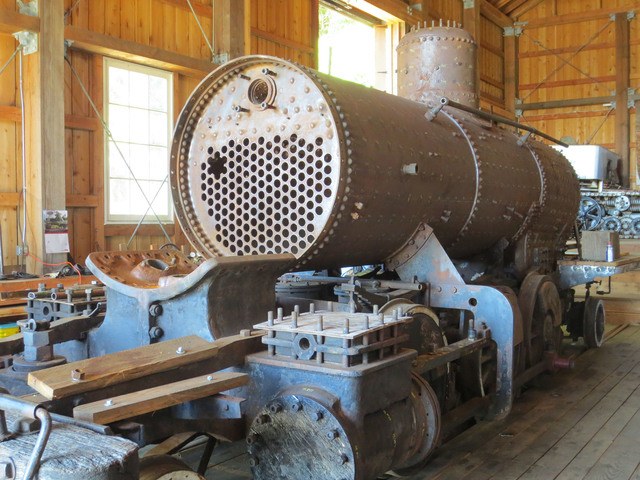Like a skeleton bleaching in the sun, the old No.45 steam engine sits stripped to her bare bones in the Polson Museum’s shop. She has been dismembered, disassembled and dispersed — but at least she’s home.
Ever since the corroded logging locomotive rolled up to its new home atop a lowboy trailer of an 18-wheeler last year, she has been gone over by a dedicated crew of 25 volunteers. Piece by rusty piece has been unbolted — or failing that — cut from her with a torch.
The crew, experts and novices alike, are determined to restore her to her former glory. Every bearing, rod, bolt and plate is being carefully examined for wear, tear and the corrosive effects of time. It’s a daunting task, but the light at the end of the tunnel is the prospect of the Harbor having a living and fire-breathing piece of its own history — a magnificent tourist attraction with some intriguing possibilities.
John Larson, director of the Polson Museum, is spearheading the effort to bring the 1906 Baldwin 2-6-2 steam locomotive to life.
“We’re undertaking a full restoration,” Larson said. “We want her to be showroom new.”
According to Larson, the project now is mainly one of thorough assessment.
“Until we do that we really don’t know how long it’s going to take to complete the work, but we’re thinking somewhere around five years,” Larson said.“There is severe decay, and right now we are finding out what parts are restorable and what parts are junk. The junk will need to be replaced and we may be able to use an old part for a pattern to fabricate a new one.”
Tim Daubert, a former engineer and fireman at the Mount Rainier Scenic Railroad said some of the parts like axles and steel tires a locomotive rolls on are just beyond repair.
“The tires on the left side are worn away because this engine was always travelling in a right hand turn during her later years,” said Daubert.
Whether from wear or weather, much of the engine will need to be replaced. Fortunately the main boiler seems to be be usable. According to Daubert the thickness of the boiler had to be measured by ultrasound every six inches to determine if it was within allowable specifications. Before it can be fired up, every part of the locomotive will be inspected by the Federal Railroad Administration for approval.
The No.45 steam engine is a piece of Harbor history. It was was built in 1906 and bought by the Polson Logging Company for its expansion away from its Hoquiam River log dump. The locomotive’s designation as the No. 45 refers to its weight — 45 tons — when it was full of fuel and hauling logs from the early-to-mid 1900s.
The engine now weighs about 78,000 pounds, Larson said. The 2-6-2 designation represents the wheel arrangement of two leading wheels, six coupled driving wheels and two trailing wheels. The first American engines with this layout were built in 1900 for use on the Midwestern prairies; thus the given the nickname “Prairie” style.
The locomotive served the Polson Logging Company faithfully until Rayonier purchased the Polson operations 1948, and then continued on with the new owners. Eventually the engine sat stationary at a railroad camp to provide steam power for the camp shops. After changing hands a few times it ended up in the posession of a California collector.
The acquisition of the engine by the Polson Museum from the reluctant owner turned out to be anything but a straightforward process. In 2014, harbor native Tim Quigg pledged $100,000 for the purchase of locomotive. Quigg is a local businessman who has strong family ties to the Harbor timber industry that go back for generations.
Larson said the restoration project would not be possible without all the help from its local supporters.
What’s the ultimate goal for the No. 45?
“Thinking ahead, Grays Harbor could really benefit from a running steam locomotive,” Larson said. “Hotels, restaurants and local businesses would benefit from it. There is a nice piece of track that goes from the Hoquiam station to Polson Road — but it’s way too early to talk about that.”



